What the Fish Monger at Whole Foods Market Is Eating

Your guide to shopping, cooking, and getting a good deal from the guy behind the counter. (ALL PHOTOGRAPHS COURTESY OF WHOLE FOODS MARKETS)
by Allison McCarthy, for Rodale’s Organic Life
How confident are you when you step up to the seafood counter? A good seafood department should be able to answer your questions without hesitation, and most market employees are enthusiastic about sharing their intel.
Related: The 10 Healthiest Fish On The Planet
Adam Ondricek, seafood team leader at Whole Foods Market (one of the Rodale 100 honorees featured here) San Francisco offers tips and tricks on everything from buying to cooking to anyone who asks. The hunter-turned-seafood-expert says the transition from cutting meat to filleting fish was easy, and his knowledge of the industry is vast. He’s a big fan of farm-raised Atlantic salmon, and he avoids anything the Monterey Bay Aquarium Seafood Watch considers “red” (meaning it’s overfished, caught, or farmed in harmful ways). Here’s what else he has to say:
A Good Fish Counter…

Has clean floors, bright lights, and shouldn’t smell fishy. It will, however, likely smell fresh and salty like the sea. That’s okay. If the smell is offensive, turn around and walk away. Examine the appearance of the market’s whole fish. If their eyes are clear, gills red, and their flesh springs back when touched, you’re at a quality place.
Fish + Seafood Departments Should Taste What They Sell

Good fish mongers try what they have on offer so that they can give you a description of the texture, flavor, and fat content, plus how best to cook what you’re buying. As a general rule, thin, delicate fillets (like sole) are best pan fried or baked (we like this recipe for Chicken-Fried Rockfish). Thick, meaty fish like salmon and halibut can hold up to grilling.
Pro Tip: Ondricek recommends investing in a special fish spatula, which has an elongated flipper that gets under the whole fillet.
Try: Customizable Wood Grill Cleaning Tool
If The Shell Remains Closed After Cooking, Do Not Eat It
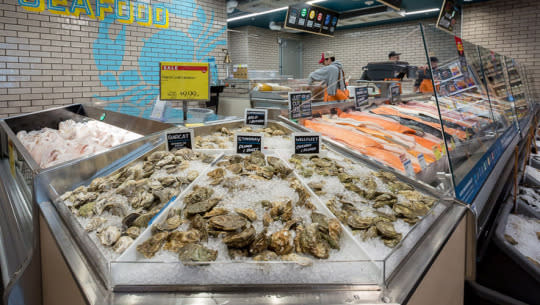
You’ve heard it before, and there are no exceptions. Shellfish that doesn’t open up after being properly cooked is likely bad and should always be thrown away. Likewise, if the shell is already open when you buy it and doesn’t close back up after tapping on it, toss it out. It’s never worth the risk. Ondricek says, “There’s no sick like shellfish sick.”
Fresh Seafood Really Does Taste Better Than Frozen
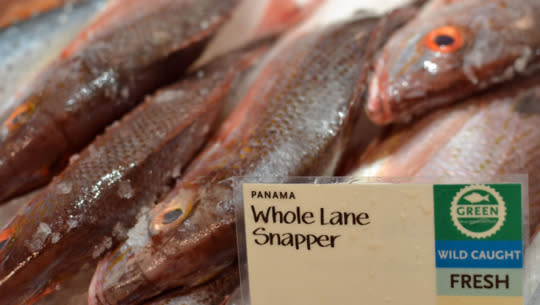
Fresh tastes, well, fresher, but it has to be cooked within three days. (You can typically identify fresh fish by its brightness and sheen.) Frozen fish doesn’t have to be used right away, but once cooked, it does have a slightly different texture and mouth feel. Thaw frozen fish either in the refrigerator or in a bowl of cold water before cooking. Letting it thaw out on the counter can compromise food safety.
Related: 8 Foods You Should Never Ever Freeze
But Frozen Is Often A Better Deal

Look for vacuum-packed seafood in your market’s frozen aisle. Whole Foods Market offers bulk club packs that can be as much as half the price of what you’d pick up at the fish counter. Packages that say IQF mean that each piece of seafood has been individually and quickly frozen. Steer clear of frozen shellfish that sticks together in clumps. It’s a sign that it’s been thawed and refrozen—and food safety could have been compromised. Plus, ice crystals could affect the texture of the flesh.
Fresh Means That Seafood Wasn’t Previously Frozen—Not That It Just Came Off The Boat

Ondricek recommends asking fish sellers when stuff came in and when it was filleted so you know its true shelf life. Finfish is fresh for about one week after it was caught. Shellfish has about a ten-day shelf life from the day it was harvested. Fish, shrimp, and scallops can sit in the fridge for up to three days. Mussels, clams, and oysters are best prepared the day you buy them but can also be stored in the refrigerator for a day or two on ice or in a bowl with a damp cloth over it. If your seller says it needs to be cooked immediately, it’s been stored too long at the market.
We Like This: Oyster Shucking Knife
If It Looks Dry, It’s Probably Been In The Case For A Day Or Two

This doesn’t mean it’s bad—just that you should cook it within a day or two. You can also tell whether fish is a day or so old if it looks opaque or has started to turn a little brownish-yellow. If the smell is offensive, it’s gone off.
Farm-Raised Fish Gets A Bad Rap, But If Done Right, It’s Better
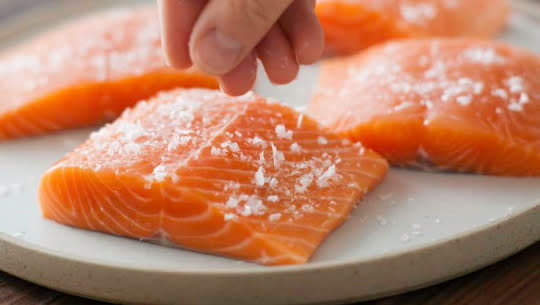
Customers prefer wild-caught because they associate farm-raised with overcrowding, growth hormones, antibiotics, clones, and genetically modified species. But when done sustainably, farm-raised is the better option because it doesn’t pull wild stock out of the world’s oceans.
Related: FDA Approves Genetically Modified Salmon
The Most Overlooked Fish That Deserves More Love Is…
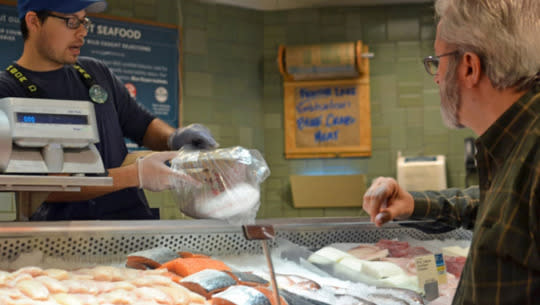
Paiche, which Ondricek gives the thumbs up. The large Amazonian river fish is an ancient species that’s prized in South American cuisine. The firm, meaty fillets are a good substitute for Chilean sea bass, halibut, and black cod. Plus, paiche is usually about half the price. It’s buttery and flaky, can be cooked many different ways, and holds up to heavy sauces. Ondricek recommends it for family sharing and fish tacos (we like this recipe for Grilled Fish Tacos).
If You’re Making Sushi At Home, Look For Fish That’s Clearly Marked Sashimi-Grade
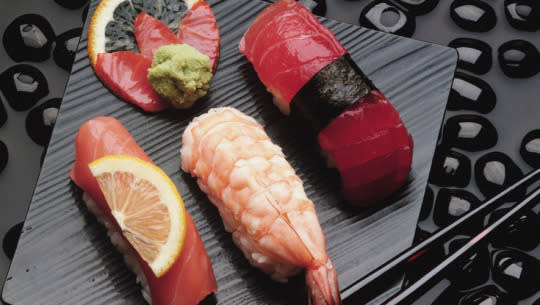
If it’s not, steer clear. For good reason, quality standards for sushi-grade fish are high and regulations strict. So much so that selling it requires a special certification process to ensure food safety. It’s so tricky to keep fresh fish 100 percent safe that even most sushi restaurants use previously frozen fish as a way to guarantee that what they serve raw is okay to eat. Some Whole Foods carry pre-packaged (to maintain cleanliness and quality standards) sashimi fish. At locations that don’t, Ondricek recommends searing fish on all sides to kill any surface bacteria before eating.
This article originally appeared on Rodale’s Organic Life.
